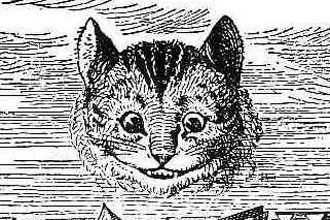|
The Cheshire Cat  This picture of the Cheshire Cat
is the original drawing for Lewis Carroll’s book “Alice’s Adventures in
Wonderland” by Sir John Tenniel in 1865. This famous grinning cat is one of the best-known characters of Alice’s Adventures in Wonderland, authored by Charles Lutwidge Dodgson (best-known by his pseudonym Lewis Carroll). This unique feline belongs to the Duchess, one of the many colorful characters Alice will meet in Wonderland. In fact, Alice first meets the Cat after she leaves the Duchess’ house with whom she had been visiting. As Alice comes out of the house, she notices a very strange cat. He’s sitting up in a tree, and he’s smiling. Alice asks the Duchess why he grins like he does, and she quickly answers, "It's a Cheshire cat, … and that's why." Alice then tells the Duchess that she didn’t know Cheshire cats could grin. In fact, she didn’t know cats in general could grin. To which the Duchess responds that all cats can grin. The Cheshire Cat appears and disappears at will, engaging Alice in amusing but sometimes vexing conversation. He constantly grins and can disappear and reappear whenever he likes. Sometimes it disappears and leaves its grin behind. “I wish you wouldn’t keep appearing and vanishing so suddenly; you make one quite giddy!” “All right,” said the Cat; and this time it vanished quite slowly, beginning with the end of the tail, and ending with the grin, which remained some time after the rest of it had gone. “Well! I’ve often seen a cat without a grin,” thought Alice; “but a grin without a cat! It’s the most curious thing I ever saw in all my life!” The Cheshire Cat is the only character in Wonderland who actually listens to Alice. The Cat plays an important role in Alice’s adventures as he instructs her in the protocols and rules that govern that strange and colorful place. He can also talk like a human. In fact, he carries very engaging – though thoroughly annoying – conversations with Alice. On most occasions, the Cat’s arguments appear to make no sense and that proves to be very aggravating to Alice. However, if you look closely, there is some sort of wisdom in his words. The following is one of the best-known passages of this beloved book. At first glance, it may seem as if what the Cat says makes no sense. But when you read it a second time, you can see the wisdom behind the Cat's words. "Cheshire-Puss," she began, rather timidly, as she did not at all know whether it would like the name: however, it only grinned a little wider. "Would you tell me, please, which way I ought to go from here?" "That depends a good deal on where you want to get to," said the Cat."I don't much care where---" said Alice. "Then it doesn't matter which way you go," said the Cat. "---So long as I get somewhere," Alice added as an explanation. "Oh you're sure to do that," said the Cat, "if you only walk long enough." ~~~ The following conversation is also well-known. Once again, you get to savor the Cheshire cat's profound wisdom... You are where you're supposed to be... according to the Cat. "But I don't want to go among mad people," Alice remarked. "Oh you can't help that," said the Cat: "we're all mad here. I'm mad, you're mad." "How do you know I'm mad?" said Alice. "You must be," said the Cat, "or you wouldn't have come here." "And how do you know that you're mad?" "To begin with," said the Cat, "a dog's not mad. You grant that?" "I suppose so," Alice said. "Well, then," the Cat went on, "you see a dog growl when it's angry, and wag its tail when it's pleased. Now I growl when I’m pleased, and wag my tail when I'm angry. Therefore I’m mad." "I call it purring, not growling," said Alice. ~~~ Another notable encounter happens when the Cat suddenly appears at the Queen’s Croquet Ground. Alice is happy to see him. When sentenced to death he baffles everyone by making his head appear without his body, sparking a massive argument between the executioner and the King and Queen of Hearts about whether something that does not have a body can indeed be beheaded. Why a Cheshire Cat? It is not 100% clear why Carroll named this character 'Cheshire Cat'. "To grin like a Cheshire Cat" was a common phrase in Carroll's day. Its origin is unknown, but it may have originated from a sign painter in Cheshire, who painted grinning lions on the sign-boards of inns in the area.Another source may be the following: when you take a good look at the 'Alice Window' in Christ Church, Oxford, you can see 3 grinning animals at the top of the Liddell's family arms. Perhaps this is what inspired Dodgson. Also, at one time, Cheshire cheeses were molded in the shape of a grinning cat. |

